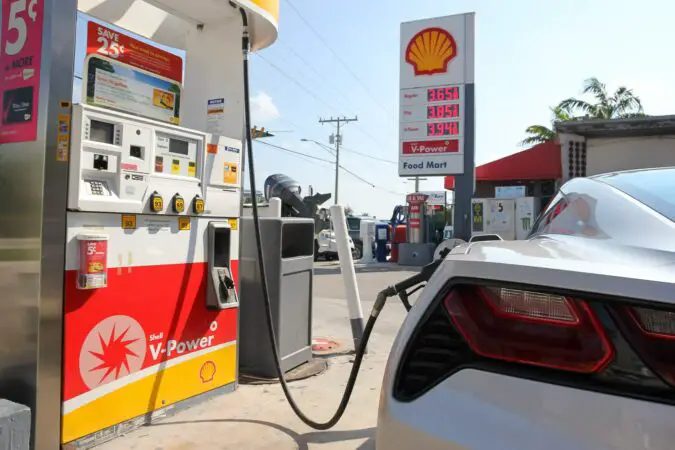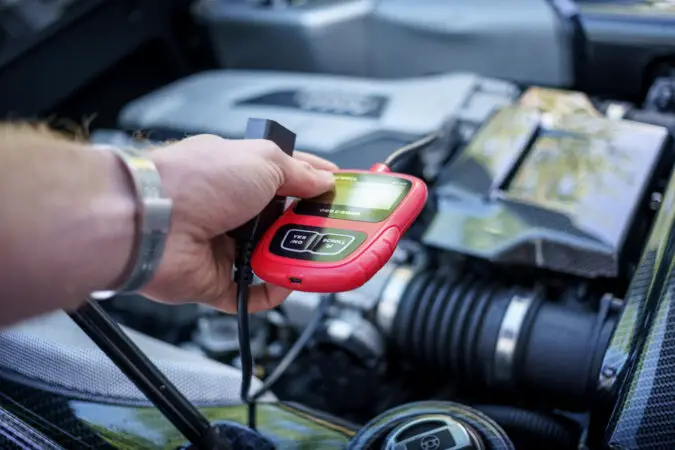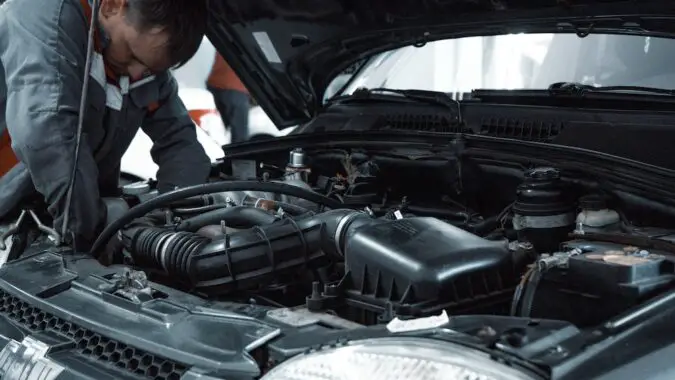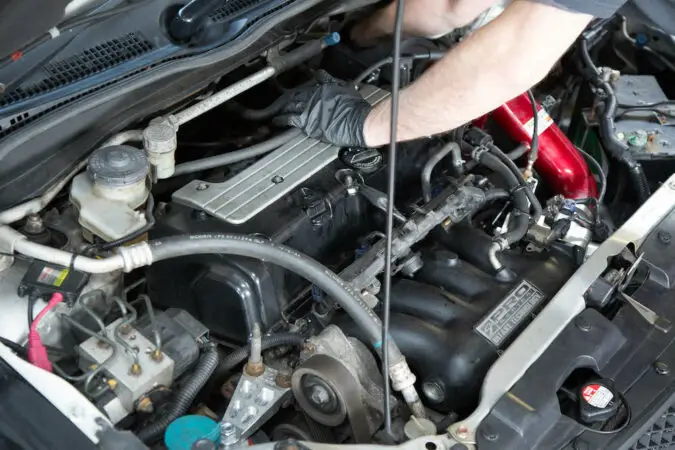Following the desire to have to breathe in less toxic air, modern automobiles have a myriad of varying emissions control devices. From trapping and minimizing harmful particulates in the exhaust, or even preventing fuel vapor to exit into the environment, every little bit helps. However, while they’re vital to the safeguarding of Mother Nature, they could still fail. Hence, prompting error codes like P0456.
If you see a check engine light, it’s often a sign that something’s quite amiss on your car. Although the underlying cause might be as simple as a loose gas cap, it’s more likely to ping you towards serious or catastrophic problems. For instance, having your car emissions control devices malfunctioning, as it’s susceptible to every now and then. That’s why diagnostic error codes like P0456 are a major headache.
This code, in particular, is tied to your car’s evaporative emissions system, whose main task is to keep fuel vapors sealed inside the gas tank. And, recycling it and circulating those vapors to the engine, which ultimately aids in optimizing fuel economy. That’s compared to having no EVAP system, as fuel vapor can freely leak into the atmosphere, which is both a fire hazard and is a danger to your health.
What Is This P0456 Code, Anyway?
If you plug in your OBD diagnostic tool into your car after seeing a check engine light (CEL), this P0456 error code could be one of many to show up. Using your OBD scanner, you’re able to extract the codes for later analysis and troubleshooting. If the P0456 trouble code appears, it’s likely accompanied by a message: “Evaporative Emissions System Small Leak Detected”. So, what does this all mean?
As we detailed earlier, most modern cars are equipped with an evaporative emissions control system, which is otherwise known as the EVAP. The EVAP system is located between the gas tank and engine, with its many constituent components scattered around. Altogether, its job is to prevent fuel vapor, whereby gasoline can evaporate very easily, even within the fuel tank, from seeping out of the tank.
Thus, preventing fuel vapor to cause pollution to the air around you, while also ensuring that you’re not left with illnesses tied with breathing them in. Moreover, keeping fuel vapor sealed shut inside the tank will further benefit your car’s fuel consumption. As fuel vapors leak out, albeit gradually, a noticeable impact will be noted in your car’s MPG figures. With an EVAP system, this won’t happen.
With your car leaking out fuel vapors, it’s been remarked that you can lose upwards of a whopping 30 gallons of gas each year. That’s merely in vapor, mind you. Not to mention, leaky fuel fumes can contribute to roughly 20% of your car’s total emissions output. Gasoline (far more so than diesel), is a highly volatile material. With warm weather, and even without any driving, it can still evaporate.
How Does Your Car’s EVAP System Work?
The EVAP system doesn’t merely seal your gas tank in, however. It has a clever system that enables a bit of outside air to vent into the tank. This is necessary while driving, as the fuel pump displaces fuel from the tank to send it to the engine. To prevent a build-up of negative pressure, which could shrink the gas tank, air is vented in to supply pressure. Besides that, there are a few other key components:
- Gas Tank – Most fuel tanks have an expansion space right near the top of the tank itself. This is so gas could expand readily on hot days, while also splashing around during a drive. This expansion space can prevent gas from overflowing the tank and leaking out into the EVAP system.
- Gas Cap – In some cars, usually older models, gas caps have pressure or vacuum relief valves built-in. Once again, this is to balance out the pressure inside and outside of the tank. With newer cars, there would be a complete sealing of the gas tank, with no relief valves or venting.
- Liquid Evaporator Separator – It can be found near the top of the expansion overflow space in the gas tank. It’s here to make sure that liquid gasoline doesn’t flow into the EVAP canister, just the vapor, as liquid fuel could easily overwhelm the EVAP system.
- EVAP Canister – It’s also known as the charcoal canister. It’s essentially a cylindrical container and is often located near the back of the engine bay. Inside, you’ll find one or two pounds of charcoal, which acts as a sort of sponge to absorb and store fuel vapors. Once your engine is running, the canister’s purge valve opens, allowing the trapped vapor to be burned inside the engine, preventing wastage.
What Does A P0456 Error Code Mean?
So then, what does a P0456 OBD diagnostic error code mean? Judging by its message mentioning an “Evaporative Emissions System Small Leak Detected”, we can find its meaning. Your car’s evaporative emissions (EVAP) control system is constantly being monitored by the ECU. Or, ‘engine control unit’, or it’s also known as the ‘engine control module’ (ECM). This is your car’s central computer brain.
Regularly, an ECU analyses your car’s vast array of componentry, sends and receives electronic signals or input, as well as records the wellbeing of your vehicle. This can include spotting errors, if certain components aren’t functioning optimally. In this case, your ECU will log error codes and will show a check engine light on your dash. By connecting an OBD scanner tool, you can pull these codes out.
Among those codes that you might spot is P0456. Your ECU will throw this message if it’s detected a small or minor leakage of fuel vapor within the EVAP system. Your car’s ECU will perform a leak test automatically when your car is turned off. This is to ensure that your car’s EVAP system is working as intended. If the EVAP system fails this test twice in a row, a P0456 trouble code will appear.
To be very specific, the leak test involves closing the vent control valve and the canister purge valve to seal the EVAP system shut. Should your EVAP system not maintain pressure, the ECU or ECM will fail it, as an inability to hold pressure evenly is a sure sign of leakage within the system. More precisely, a “small leak” is specified as a leak smaller or around 0.020-inches in diameter. Quite tiny, therefore.
What’s Caused This P0456 Error Code To Appear?
So, just what is it that’s caused a P0456 error code to come on in the first place? It could likely be:
- Loose Or Damaged Gas Cap – It’s the most common trigger of a P0456 code. If your gas cap isn’t shut tightly, fuel vapor could very easily escape through the filler. Hence, your EVAP system isn’t able to function as designed. Alternatively, it might also be triggered due to a damaged gas cap. Once again, this compromises the seal around the gas tank, allowing vapor to slowly seep out into the air.
- EVAP Vacuum Or Fuel Hose – There’s a possibility the hoses are leaking, enabling fuel vapor to leak out of the evaporative emissions control system. Otherwise, another possibility would be that these hoses have been disconnected or dislodged.
- Purge Control Or Vent Valve – Once again, these could also be vulnerable to small leaks, bypassing the EVAP control.
- Leaking EVAP Canister – The charcoal canister itself might have leaks, which would prevent it from trapping and storing fuel vapor effectively.
- Fuel Tank – Worse, the entire fuel tank itself might be leaking. Not only vapor, but liquid gasoline will also find its way out of the system.
- Leak Detection Pump – This is the component that pressurizes the EVAP system, tests it, and prompts the ECU to show a check engine light if the leak test fails. The pump could’ve failed. In effect, it might either show false positives in the leak test results or have conducted a faulty test.
- Fuel Tank Pressure Sensor (FTP) – The FTP sensor is placed at the top of the fuel tank, and its role is to measure the pressure within the tank. Combined with the leak detection pump, it’s here to detect if a leak is present in the EVAP system.
What Are The Symptoms To Come With The P0456 Code?
Although it’s a very subtle issue, you might notice some of these P0456 symptoms:
- Check Engine Light – As is explained already, your car’s ECU should be the first in line to detect if there are any issues early on. When these have been found, such as an EVAP leak, it’ll throw a check engine light to warn you, as a prompt to get your car checked out.
- Gasoline Smell – Seeing how fuel vapor is leaking out, you might be able to pick up a gasoline smell. This could be fairly faint, if the EVAP leakage is only quite small, and has only recently occurred. But leave it be for long enough, and the smell of leaking gas will get stronger.
- Poor Fuel Economy – Remember, fuel vapor leaking out is akin to having liquid fuel dripping out of the gas tank. While a fine mist might not seem like much, it can add up to a significant loss of fuel if given the time. Therefore, you could start seeing your MPG figures dropping gradually.
- Failed Emissions Test – Here in the US, cars are required to regularly undergo emissions testing. This won’t just measure the tailpipe emissions, however. They would also take into account the rest of the car, such as the EVAP system. With fuel vapor leaking, you’ll most assuredly fail an emissions test.
It’s worth mentioning that most of these symptoms might go right over your head. They’re easy to miss, and would sometimes take a bit of time before you can really notice them. For instance, being able to smell fuel, or seeing a drop in the fuel economy. The most obvious symptom that comes with a P0456 issue is that check engine light. Once it illuminates, it’s wise to get your car inspected immediately.
How Can You Diagnose A P0456 Error Code?
While the leak might be fairly small, all things considered in regards to EVAP control system leaking, it’s those tiny leaks that are the hardest to pin down. Thankfully, there are concrete steps that we can take to try to diagnose a P0456 error code. This should at least help us narrow down the point of failure within the EVAP system. Subsequently, we could later solve this issue with a repair or replacement.
In order of difficulty, here are some steps you can take to diagnose, and perhaps even solve the P0456 issue all at once:
Option 1 – Confirm That You (Only) Have A P0456 Error Code
First and foremost, you should grab an OBD diagnostics tool, and confirm that you have a P0456 code present in your car. It’s vital that you ascertain whether it’s the only error code to come up, or if there are any other trouble codes alongside it, as well.
If you happen to find other evaporative emissions-related error codes, you should diagnose and solve those ones first. For example, rather than a small leak, you might have a faulty fuel pressure sensor or a solenoid problem.
Other alternatives include a leaking charcoal canister, or perhaps a larger EVAP leak somewhere else in the system. Doing this will help save precious time and money, as a P0456 code can appear as a side-effect of some other issue. Solving that may automatically fix a small leak, too.
Option 2 – Tighten The Gas Cap (And Clear Out The Codes)
The most innocent mistake that you could’ve made to prompt the P0456 error to appear, is forgetting to properly tighten up the gas cap during your last fill-up. When there’s an insufficient seal between the gas tank, fuel filler, and the gas cap, fuel vapor could slowly seep out.
In this circumstance, it’ll fail your car’s automated fuel vapor leak tests, forcing the P0456 error code to light up the check engine light. The simplest diagnosis that you can undertake is simply tightening the gas cap. Remember the gas cap should audibly click once it’s firmly in place.
Unfortunately, and even once you’ve done that, the check engine light still won’t go away. Assuming you already have an OBD diagnostics tool in hand, which you’ve used previously to extract the P0456 error code from the ECU, plug that back into the car.
Using the OBD scanner, you can manually reset the check engine light by clearing out all the trouble codes stored inside the ECU. Having completed this, there are two possible outcomes:
- If the check engine light stays off, or if you’re no longer getting a P0456 error code through your OBD tool. In this scenario, you’ve successfully fixed the EVAP leak at hand, which was likely down to your gas cap being somewhat loose.
- If the check engine light re-emerges again, the source of the EVAP leak must be found elsewhere. Or, it might be that your gas cap is damaged or faulty, and isn’t able to create a secure seal. To better understand which cause it might be, further diagnosis may be required.
NOTE: Your ECU’s EVAP leak test re-runs periodically every 2 days or so.
Option 3 – Inspect EVAP Components For Visible Damage
Having written off the possibility of it being a gas cap, you could proceed with inspecting the rest of the EVAP system. You can take a look at the fuel filler and gas tank to see if there’s visible damage. While you’re there, take a peek under the car, just in case you’re leaking liquid fuel.
Moving towards the front, you should now take a peek at the EVAP components lying in the engine bay. First, check the EVAP hoses, which are mounted to the engine’s air intakes. In particular, see if the hoses are cracked, knocked loose, or have been disconnected.
If that’s all good, you can move closer to the rear of the engine compartment. Here, you may find the EVAP (charcoal) canister, which looks like a cylindrical can or barrel. Take a close look at the canister, and note down if there’s any damage to it. For example, clear signs of fuel leaking out.
Option 4 – Check The Purge Control Valve
Next up, we can move on to the purge control valve. You’d usually find this on or near the air intakes, as well. When the engine isn’t running, this purge valve should remain closed, and won’t open when your car is turned off.
Unfortunately, it’s also possible for the control valves to get stuck. The purge valve vents, especially, could be blocked by dirt, debris, contaminants, or even cobwebs. Thus, causing leaks to appear. You can test and find out whether they’re in good working order by:
- Make sure the engine remains off, without the key in the ignition.
- Disconnect the aforementioned EVAP hoses from the air intakes.
- With lungs filled with air, blow into the valves.
- If they still won’t open after blowing into them, it’s a good sign that the seals are in good shape.
Option 5 – Check The Canister Vent Control Valve
Its functionality is similar to the purge control valve. It’s not powered on while your car isn’t running, and could get stuck in place. Therefore, the previous diagnosis steps apply here, too:
- Ensure that the engine is turned off, with no keys in the ignition.
- Remove the EVAP hoses that are connected to the canister vent control valve.
- Unplug the control valve, and un-mount it from your vehicle.
- Once it’s been removed, you can blow through it.
- If no air passes through, you can proceed to test the electrics of the valve.
- Connect a power supply (at least 12V or higher) to one side of the canister.
- On the other connector, attach it to a grounded connection.
- The vents should open and close with a complete circuit running through them.
- If it doesn’t open, connect a multimeter to the control valve.
- There should be a voltage reading (at least 12V), showing a flow of electricity.
- Should this not be the case, you’ve at least determined that it’s an electrical problem.
Option 6 – Smoke Machine Leak Test
Alas, it might be the case that the EVAP leak is so small, it may be challenging to even pinpoint. If this is the case, you’ll need to get yourself an EVAP smoke machine. Or, consign this task to a mechanic, as they typically have these professional tools on hand.
An EVAP smoke machine will pump harmless smoke through your EVAP system. This should expedite the diagnosis process very rapidly, as you could more easily trace the flow of smoke. And, whether or not there’s a confirmed EVAP leak, and where exactly is it located.
How Can You Solve A P0456 Error Code For Good?
Depending on the true cause of the P0456 code, whether it’s an actual leak or if there’s an electrical fault, the solutions and costs necessary to fix them will vary. Here are a few examples to solve a leak in your EVAP system:
- New Gas Cap – The most frequent cause of a P0456 error code is a damaged or missing gas cap. If that’s so, replacements are inexpensive, as you can often find them for around $10, or just slightly more. Just make sure you purchase a gas cap that’s made to fit the make and model of your car.
- EVAP Purge Control Valve Replacement – $50 to $300
- Charcoal (EVAP) Canister Vent Control Valve Replacement – $50 to $300
- EVAP Hoses Replacement – $50 to $150
- Charcoal (EVAP) Canister Replacement – $200 to $600
- Fuel Tank Replacement – $500 to $600 (this is applicable if the fuel vapor leaks stem from the gas tank, where the entire unit has to be replaced)
- Leak Detection Pump Replacement – $150 to $400
- Fuel Tank Pressure Sensor Replacement – $250 to $350
- Diagnostics Fee – $200 to $300 (this is charged by the workshop to run all the diagnostics and testing necessary to pin down the root cause of a P0456 error code)
P0456 Code: Facts
- P0456 is an OBD-II generic code indicating that the engine control module (ECM) has detected a very small leak in the evaporative system during the vehicle off-testing.
- The code is activated by the ECM if the test fails twice in a row.
- A small leak in any of the system components or hose connections can cause the P0456 code.
- The gas cap vent and the purge vent valve not sealing completely are the two most common causes of the P0456 code.
- The Check Engine Light will be illuminated and the code is set in ECM memory when the P0456 code is detected.
- A mechanic diagnoses the P0456 code by scanning codes, inspecting the entire vapor purge valve system, performing a smoke leakage test on the fuel vapor system, and checking the purge control valve.
- Common mistakes when diagnosing the P0456 code include not verifying the leak and replacing parts that may or may not be the problem and not checking for any technical service bulletins that may have a fix for the code.
- Code P0456 causes the Check Engine Light to go on, which alone will cause a failed emission test.
- If the leak is not found, the ECM monitors will not pass emissions even if the Check Engine Light is turned off.
- Replacing a leaking gas cap, a leaking or clogged purge vent valve, or a leaking purge valve can fix the P0456 code.
Final Thoughts On A P0456 Error Code
That then should sum up our guide on P0456 error codes. Among all the potential problems that may come up with your car ownership experience, small EVAP leaks like these aren’t catastrophic. It’s still possible for you to keep driving around for a little while. Albeit, you’ll have to stare at an illuminated check engine light the whole time. And, you might experience poorer emissions and fuel economy.
Although, it’s always a good idea to have it checked out as soon as possible. A tiny leak in the EVAP is still an issue that shouldn’t be ignored. Leave it be for too long, and it might prompt further damage to the rest of the EVAP system. Plus, it’s never a good idea to leave fuel leaks to go unattended, vapor or otherwise. While not gut-wrenching, do get that P0456 error inspected and fixed, ASAP!






